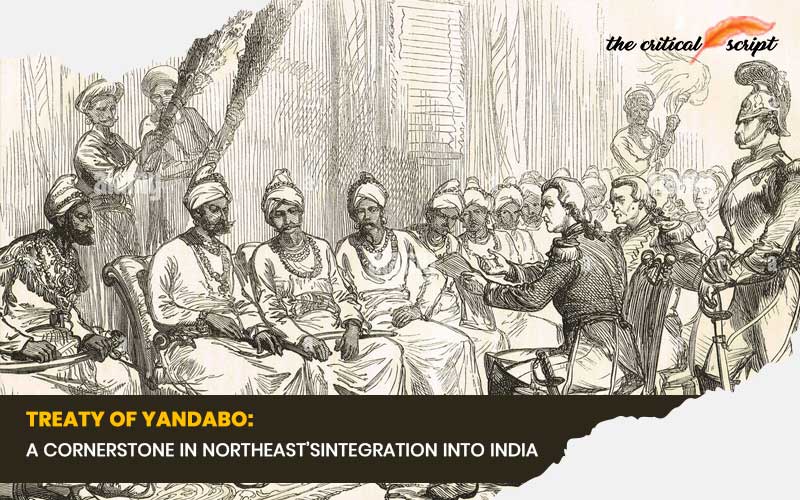
Treaty of Yandabo: A Cornerstone in Northeast’sintegration into India
The formation
and successful operations of the Assam Levy and Manipur Levy during the First
Anglo-Burmese War (1824-1826) were pivotal in the British conquest of Northeast.
These events laid the groundwork for the integration of these regions into
British India, eventually becoming part of modern India.
Background and Formation
The region of Northeast, comprising Assam and its
neighboring territories, was strategically important for the British due to its
geographical location and resources. Control over Assam meant securing vital
trade routes and access to valuable resources, as well as establishing a buffer
against Burmese expansion.
In response to the Burmese invasion and occupation, the British formed
the Assam Levy by recruiting local Assamese fighters who had been displaced or
were resisting Burmese control. The Levy was trained and led by British
officers, integrating local knowledge and military expertise. This combination
proved to be a significant advantage in the challenging terrain of Assam. The
Manipuri Levy was meanwhile trained by British officers, Captain Grant and
Lieutenant R.B. Pemberton.
The Assam Levy, alongside British troops, engaged
in several key battles and skirmishes to expel Burmese forces from Assam. Their
local knowledge was crucial in navigating the difficult terrain and conducting
effective military operations. The Levy's contributions were instrumental in
key engagements, such as the battles for the recapture of strategic locations
like Rangpur (modern-day Sivasagar).
The Levy played a significant role in the
successful recapture of Assam, culminating in the defeat of Burmese forces.
This not only liberated the region but also established British military and
political dominance. The success of these operations ensured British control
over Assam and laid the foundation for further territorial expansion.
The Manipuri Levy, along with other British and
allied forces, engaged the Burmese in several battles. The campaign was marked
by difficult terrain and challenging logistics but ultimately proved
successful. By February 1826, Gambhir Singh and the Manipuri Levy had
successfully recaptured Manipur. They extended the territory's boundary beyond
the Ningthee River, solidifying control and ending Burmese occupation.
Broader Implications for British Expansion
Treaty of Yandabo (1826)
End of the First
Anglo-Burmese War: The Treaty
of Yandabo marked the end of the First Anglo-Burmese War, with significant
territorial gains for the British. Burma ceded control of Assam and other
regions, recognizing the independence of Manipur and other areas. This treaty
effectively ended Burmese influence in Northeast and solidified British control
over Assam.
Establishment of British
Control: The treaty placed Assam under British control,
establishing a foundation for further expansion into Northeast. The British
were able to assert their dominance and integrate Assam into their colonial
framework, setting the stage for future annexations in the region.
Integration into British
India: Following the war, the British began integrating
Assam into their colonial administration. This involved reorganizing the region’s
governance, establishing infrastructure, and asserting economic control. The
introduction of British administrative practices and infrastructure development
facilitated the region's integration into the broader colonial economy.
Local Alliances and Administration: The British continued to rely on alliances with
local leaders, such as PurandarSingha, who was briefly reinstated as a
tributary ruler. However, this autonomy was short-lived as the British moved
towards direct administration. The gradual shift from indirect to direct
control exemplified the British strategy of consolidating their hold over newly
acquired territories.
Continued Expansion in the Northeast
Anglo-Manipur War (1891): The Anglo-Manipur War further exemplified British
efforts to consolidate control in the region. Following this conflict, Manipur
was fully annexed and placed under British administration. The war demonstrated
the British commitment to maintaining and expanding their influence in the
strategically important Northeast.
Further Annexations: The British continued to expand their influence
in the Northeast, annexing other regions such as Nagaland, Mizoram, and
Arunachal Pradesh over the following decades. This was part of a broader
strategy to secure their northeastern frontier and integrate these areas into
British India. Each annexation involved strategic military and political
maneuvers, solidifying British control over the region.
Colonial Legacy
Infrastructure and
Administration: The British left a
lasting impact on the region through the establishment of infrastructure,
administrative systems, and economic policies. These developments facilitated
the integration of Northeast into the broader Indian subcontinent. Railways,
roads, and administrative buildings constructed during the colonial period
continue to serve as vital infrastructure.
Cultural and Political
Changes: British colonial rule also brought about
significant cultural and political changes, influencing the social fabric of
the region. The introduction of Western education, legal systems, and political
institutions had long-lasting effects on the societies of Northeast.
Post-Independence Integration
Formation of Modern India: Following Indian independence in 1947, the
territories of Northeast, previously under British rule, became integral parts
of the newly formed Republic of India. The legacy of British administration
helped facilitate the integration of these diverse regions into a single
national framework.
State Formation: Over time, these territories were reorganized
into various states within India, each with its own unique identity and
administrative structure. The creation of states like Assam, Nagaland, Mizoram,
and Arunachal Pradesh ensured that the distinct cultural and historical
identities of these regions were recognized within the Indian Union.
Had it not been for the Treaty of
Yandabo, the history of Northeast might have unfolded very differently. The
treaty was a decisive moment that ended Burmese ambitions in the region and
established British dominance. This dominance, in turn, paved the way for the
eventual integration of Northeast into modern India. The Treaty of Yandabo was
more than just a peace agreement; it was a cornerstone for the geopolitical and
administrative transformations that followed, shaping the future of
Northeastand its place within the Indian nation.
Disclaimer: The opinions expressed in this article are those of the author's. They do not purport to reflect the opinions or views of The Critical Script or its editor.

Newsletter!!!
Subscribe to our weekly Newsletter and stay tuned.

















Related Comments